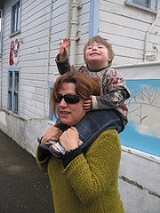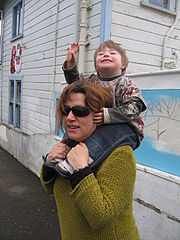
Piggy-back
Encyclopedia

Etymology
Piggyback was started in the sixteenth century as pick pack. This meant to carry something on the back or shoulders, pick being the medieval version of pitch. Shortly thereafter pickpack meant a ride on somebody’s shoulders. The phrase was changed to piggy in the 19th century because pick had lost its original meaning. Its first appearance in literature was 1838 in Britain and the 1860s in North American.Piggyback ride
One common variant of the piggyback involves the carried person sitting on the carrier's shoulders with a leg on each side of the carrier's neck and dangling downwards.Alternatively the carried person is positioned lower laterally along the carrier's back, legs extending forward around the carrier's waist to provide balance
Balance (ability)
In biomechanics, balance is an ability to maintain the center of gravity of a body within the base of support with minimal postural sway. When exercising the ability to balance, one is said to be balancing....
and possibly be supported by the carrier's arms. The latter position requires less physical strength and is safer for both persons, however by being positioned on one's shoulders the carried person's weight is evenly balanced and thus over time is less exhausting.
Other uses
This expression is used by analogy in several contexts, such as in ophthalmologyOphthalmology
Ophthalmology is the branch of medicine that deals with the anatomy, physiology and diseases of the eye. An ophthalmologist is a specialist in medical and surgical eye problems...
, electrical engineering
Electrical engineering
Electrical engineering is a field of engineering that generally deals with the study and application of electricity, electronics and electromagnetism. The field first became an identifiable occupation in the late nineteenth century after commercialization of the electric telegraph and electrical...
, computer engineering, computer science, structural geology
Structural geology
Structural geology is the study of the three-dimensional distribution of rock units with respect to their deformational histories. The primary goal of structural geology is to use measurements of present-day rock geometries to uncover information about the history of deformation in the rocks, and...
and various transport systems, e.g. rail transport, air transport and intermodal freight transport
Intermodal freight transport
Intermodal freight transport involves the transportation of freight in an intermodal container or vehicle, using multiple modes of transportation , without any handling of the freight itself when changing modes. The method reduces cargo handling, and so improves security, reduces damages and...
. An example in air transport was the 1930s British Short Mayo Composite
Short Mayo Composite
The Short Mayo Composite was a piggy-back long-range seaplane/flying boat combination produced by Short Brothers to provide a reliable long-range air transport service to the United States and the far reaches of the British Empire and the Commonwealth....
, in which a smaller floatplane
Floatplane
A floatplane is a type of seaplane, with slender pontoons mounted under the fuselage; only the floats of a floatplane normally come into contact with water, with the fuselage remaining above water...
aircraft, the four-engined "Mercury", was carried aloft on the back of a larger four-engined flying boat
Flying boat
A flying boat is a fixed-winged seaplane with a hull, allowing it to land on water. It differs from a float plane as it uses a purpose-designed fuselage which can float, granting the aircraft buoyancy. Flying boats may be stabilized by under-wing floats or by wing-like projections from the fuselage...
named "Maia"; this enabled the Mercury to achieve a greater range than would have been possible had it taken off under its own power. In space transportation systems a satellite on the top of a launcher assembly is said to be "piggybacked" on the launcher. In electrical engineering a secondary integrated circuit may be piggy-backed onto a primary one e.g. to replace without soldering. If the second chip is mounted leads up, the primary IC is said to be dead-roached instead, since it looks like a dead cockroach
Cockroach
Cockroaches are insects of the order Blattaria or Blattodea, of which about 30 species out of 4,500 total are associated with human habitations...
with legs up.
The term piggy-back is also used for a product distribution strategy, where two companies that have product lines that complement each other grant access to each other's distribution channel structures so they may both expand their markets (e.g. abroad). This is a variation to the principle of cross selling.
For the purposes of multiple people being stacked onto one piggyback ride, the disambiguation for a single rider is called a "double," for two riders, it is a "triple," and for 3 riders, it is a "quadruple." The operative word that is omitted each time is "stack," because each modifier implies that the action performed is a "double stack, triple stack, or quadruple stack," and so forth.
Rail

Semi-trailer
A semi-trailer is a trailer without a front axle. A large proportion of its weight is supported by a road tractor, a detachable front axle assembly known as a dolly, or the tail of another trailer...
s or containers
Intermodal container
An intermodal container is a standardized reusable steel box used for the safe, efficient and secure storage and movement of materials and products within a global containerized intermodal freight transport system...
in a train atop a flatcar (intermodal freight transport
Intermodal freight transport
Intermodal freight transport involves the transportation of freight in an intermodal container or vehicle, using multiple modes of transportation , without any handling of the freight itself when changing modes. The method reduces cargo handling, and so improves security, reduces damages and...
) is referred to as "piggybacking."
(See also Autorack
Autorack
An autorack, also known as an auto carrier, is a specialized piece of railroad rolling stock used to transport automobiles and light trucks, generally from factories to automotive distributors...
).
It is also possible to carry a railway wagon of one gauge on a flat railway wagon (transporter wagon
Transporter wagon
A transporter wagon, in railway terminology, is a wagon or railroad car designed to carry other railway equipment. Normally, it is used to transport equipment of a different rail gauge...
) of another gauge; indeed, whole trains of one gauge can be carried on a train of flat wagons of another gauge as was done temporarily in Australia for a few years from 1955 between Telford
Telford, South Australia
Telford Cut is a coal mine in South Australia and current terminus of the Port Augusta to Telford railway.- Transport :The railway finishes in a balloon loop. The standard gauge railway used to continue to Marree until about 1980, while the narrow gauge railway used to continue to Alice Springs.-...
and Port Augusta
Port Augusta, South Australia
-Electricity generation:Electricity is generated at the Playford B and Northern power stations from brown coal mined at Leigh Creek, 250 km to the north...
.
Marine
Small ships of all kinds can be piggybacked on larger ships.- LifeboatLifeboat (rescue)A rescue lifeboat is a boat rescue craft which is used to attend a vessel in distress, or its survivors, to rescue crewmen and passengers. It can be hand pulled, sail powered or powered by an engine...
s - Landing CraftLanding craftLanding craft are boats and seagoing vessels used to convey a landing force from the sea to the shore during an amphibious assault. Most renowned are those used to storm the beaches of Normandy, the Mediterranean, and many Pacific islands during WWII...
such as at D-DayD-DayD-Day is a term often used in military parlance to denote the day on which a combat attack or operation is to be initiated. "D-Day" often represents a variable, designating the day upon which some significant event will occur or has occurred; see Military designation of days and hours for similar... - MinesweepersMinesweeper (ship)A minesweeper is a small naval warship designed to counter the threat posed by naval mines. Minesweepers generally detect then neutralize mines in advance of other naval operations.-History:...
on Motherships - Midget submarineMidget submarineA midget submarine is any submarine under 150 tons, typically operated by a crew of one or two but sometimes up to 6 or 8, with little or no on-board living accommodation...
s on big Submarines such as used for 1942 Japanese submarine attack on SydneyAttack on Sydney HarbourIn late May and early June 1942, during World War II, submarines belonging to the Imperial Japanese Navy made a series of attacks on the cities of Sydney and Newcastle in New South Wales, Australia...
.

